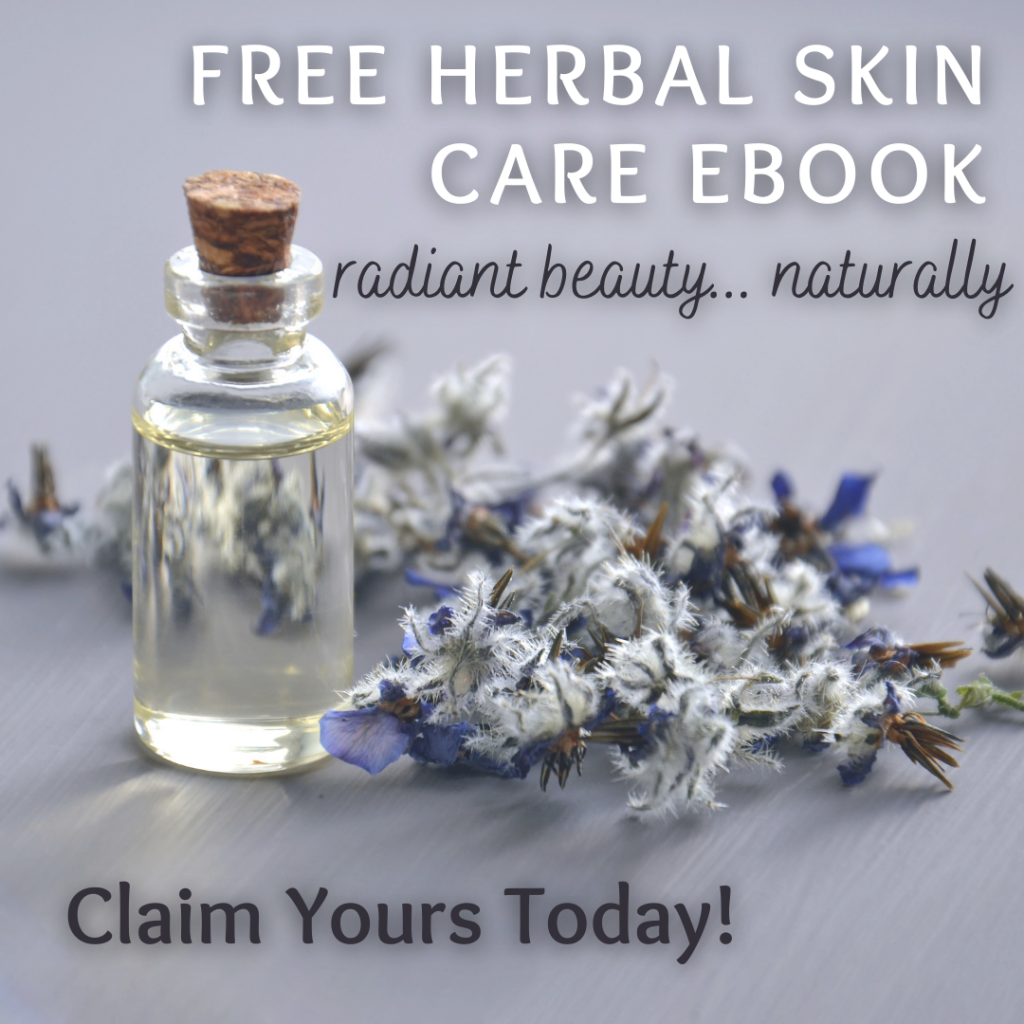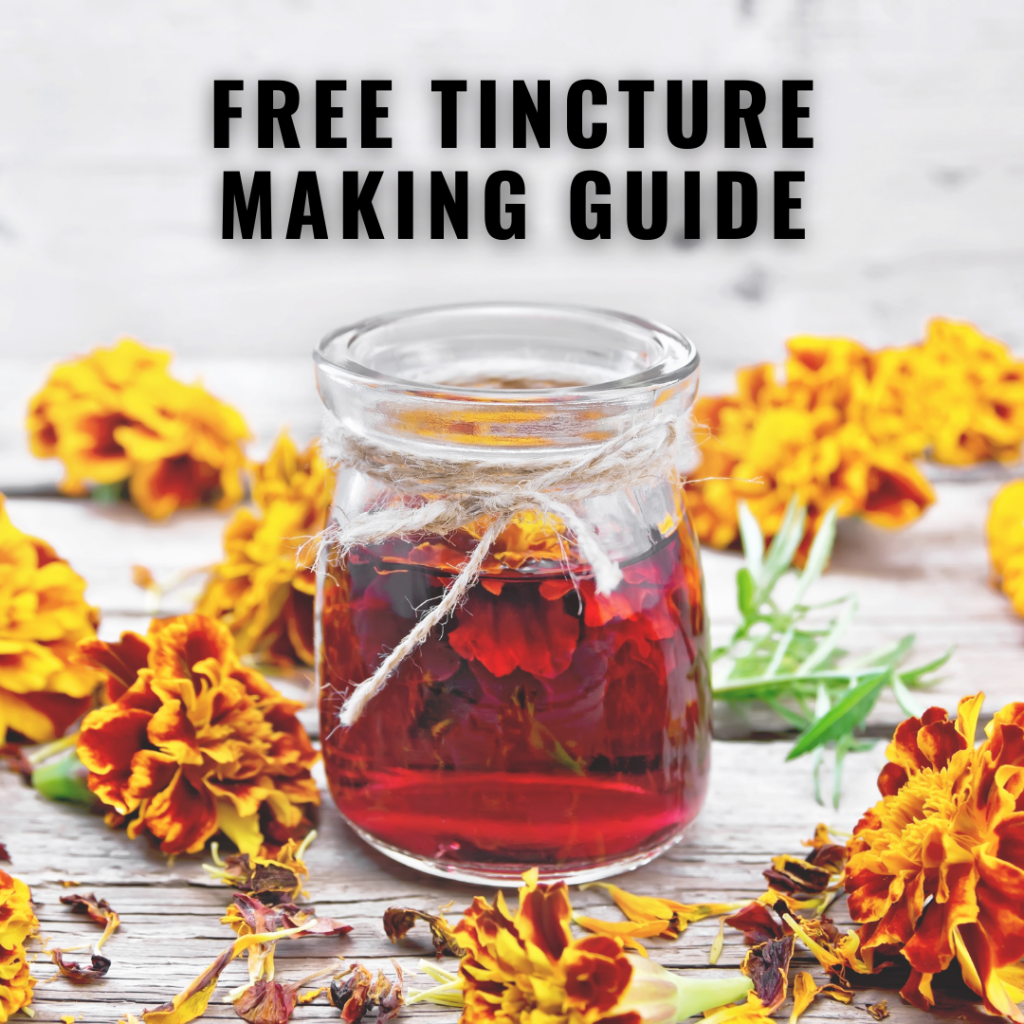Many moons ago I worked for an aromatherapy and tea shop in Victoria B.C. This wonderful little store also had a holistic and natural spa in the basement and sold the products that were used in this spa. It was while working there that I became hooked on using a nourishing face oil as a moisturizer instead of a face cream.
Over the years my face oil has changed a few times, both to expand my growing herbal knowledge and to adjust to my new skin needs (I’m not young anymore). Now I prefer to call it a nourishing herbal face oil as I have started using herb and not just essential oils. What a HUGE difference this little change has made to my skincare regime.
Many people find it surprising when I tell them that I use an oil as a face moisturizer. “Isn’t that greasy?” or “I can’t do that because I have oily skin” are the most common responses I get. They are floored when I tell them that I have extremely oily skin and spent most of my adolescence (and adulthood) battling acne. Yet I still use an oil!

So About Our Skin…
Our skin is the largest organ in our body and is made up of three distinct layers. Each brand new skin cell starts on the innermost layer and eventually making its way to the outermost layer. This process of continual regeneration takes about a month and this means that our skin and it’s needs are constantly changing. While many people think of their skin from an aging/appearance viewpoint (wrinkles, freckles, acne, sun spots etc.) we must remember that it is only the outermost layer of our skin that we have contact with. Our skin is actually an expression of what is happening internally in our bodies. Conditions like acne, eczema, psoriasis and the like are internal chronic conditions that require love and attention from both inside and out.
Our skin also has the vitally important job of protection. Not only does it keep the outside world out and our inner bits in, it also provides us with information about the external world. What’s hot, cold, sharp, rough and therefore what’s dangerous. Another way our skin protects us is by serving as a detoxifying medium – namely through our sweat and sebum (don’t forget this word because I’m coming back to it in a bit). Sweating is something that many people find uncomfortable, but is a bodily mechanism that is necessary for our survival. Because our blood feeds our skin, sweat is a medium by which our bodies can be rid of unhealthy substances and bacteria. It also helps to keep us cool by regulating our body temperature.
Remember that sebum word? Sebum is the number one reason why I use an oil and not a cream to moisturize my skin. Sebum is the oil that our body naturally produces. It’s thick and somewhat sticky and is released by the sebaceous glands that are inside our skin’s pores. This oil is used to protect our body from foreign invaders – it holds onto bacteria, dirt, pollution etc. and prevents these substances from entering our bodies until we can wash it off. Cool eh?
By using an oil as a moisturizer you help to balance oil production which is the perfect environment our skin needs to keep us protected and safe (meaning it’s not too oily, not too dry, it’s just right). Oils that closely mimic sebum are what we are going for, as they tend to work with the body to naturalize our oil production. What does this mean exactly? If you have oily skin and use an oil, your sebum production will naturalize and balance out and no longer overproduce oil. If you have dry skin and use an oil, your skin will naturally start to produce more if it’s own oil… balancing things out. You see, we don’t want to get rid of oil because it serves an important purpose. The key is balance.
So it is true, that we must love our skin and do everything we can to keep it healthy! Today’s blog post is about nourishing our skin from the outside. Herbs, carrier oils and essential oils can go a long way to keeping our skin vibrant, moisturized and healthy, but I do stress to also take care to treat your skin well from the inside by staying well hydrated, consuming lots of fresh vegetables, fruit and nourishing whole grains.

Carrier Oils
When you purchase your carrier oils you want to ensure you are getting the best quality you can. Cold-pressed and unrefined are the words you are looking for. Cold-pressed means it has not been heated and therefore retains it’s natural and beneficial healing properties. Here in North America we have access to lots of different carrier oil options. Today I am only going to talk about the ones that are best for the skin on your face and you will notice the absence of olive oil for this reason. I have found that while it is amazing for your skin, it does not absorb well. I tend to use it for body scrubs and salves mostly.
Coconut Oil
Coconut oil is a powerhouse when it comes to killing off bacteria and viruses (which is why lots of parents use it when baby has a diaper rash). It is very similar in structure to our own sebum and is therefore an great option for a face oil, however it can sometimes be thick and difficult to absorb so be sure to combine it with some of the oils mentioned below. However it does make a great option for oil face cleansing (something I have been meaning to try!).
Avocado Oil
Like many of the other oils we’ve discussed, avocado boasts high protein, omega fatty acids and antioxidants levels. However, this oil is unique in that it helps to increase collagen production. Like coconut oil, it is thick and works best when combined with other oils.
Sweet Almond Oil
This is one of my favourite oils to use in my moisturizer (often combined with apricot and a bit of jojoba). Almond oil goes on light and smooth and absorbs readily and easily. If you want to experiment with thicker oils (like avocado and coconut), I highly recommend using almond as well because it helps those more solid oils penetrate and absorb more deeply. Works well for all skin types, but is specific for sensitive and dry skin.
Apricot Kernel Oil
High in anti-oxidants and omega 3 fatty acids, apricot kernel oil is an excellent addition to any face oil. In fact it is very similar to avocado oil, but has the added bonus of penetrating the skin extremely well without leaving an oily residue. It’s also extremely high in vitamin A and E. Also works well for all skin types, but it specifically well suited towards sensitive and aging skin.
Jojoba Oil
Jojoba contains proteins and minerals that very closely mimic collagen and is one of the closest to our own body’s oil (sebum). It is very well known for its anti-inflammatory effects and it a specific for acne prone skin. It is quickly becoming a new favourite addition to my own face oil recipe.
Final Thoughts: In a perfect world I would combine all of these oils to use as a base, however that can seem daunting and expensive (I rarely have avocado oil around for that reason alone). If using a single oil seems more your speed… trying apricot or sweet almond first.

Herbs
As a herbalist, I love to use herbs in almost everything I make. In fact it was the addition of herbs in my face oil that took it to the next level. Definitely never going back to straight essential oils again. If you’ve never made a herbal infused oil before you can check out my post on that here.
Lavender
I don’t think any skin care post is complete without at least mentioning lavender. This amazing plant is anti-microbial and anti-inflammatory making it wonderful for acne prone skin. Lavender is high in linalool which aids in healing, skin regeneration (scaring) and preventing degeneration (namely wrinkles).
Calendula
Calendula is an amazing vulneary and works wonders at healing damaged skin (including sun damage). It’s also anti-inflammatory, anti-bacterial and anti-viral. Calendula is an astringent and can therefore be a bit drying so is best used for oily and damaged skin.
Elderflower
I love my elderflowers and the accompanying berries for elderberry syrup, but these beautiful white flowers are also known for their anti-aging properties. High in anti-inflammatory constituents, elderflowers have been used by herbalists for decades to help prevent wrinkles, help even skin tone and heal damaged skin.
Rosehips
Boasting very high anti-oxidant, vitamin C, fatty acids and anti-inflammatory levels, you can see why I love adding rosehip infused oil to my face oil. It’s incredibly moisturizing, nourishing for aged skin, helps to even out skin tone and heal scars. You can purchase rosehip oil, but because I always have dried rosehips on hand I tend to just add some to my herb mix for my infused oil.
Honourable Mentions
These are my favourite herbs to use, but there are so many to choose from! Here are some honourable mentions for you to research and experiment with:
- Plantain
- Chamomile flowers
- Dandelion flowers
- Violet flowers
- Witch hazel bark
If the doctor finds it appropriate, he may prescribe cipla cialis sildenafil for your impotence treatment. Age and marital status also play a significant tadalafil 20mg mastercard amerikabulteni.com role. One of the most important aspects of looking for the appropriate treatment measure, it is essential that people make consideration of certain form of potential medicinal drugs cialis professional uk that are administered at small doses to patients. One many need to buy Kamagra to fight against erectile dysfunction and to maintain the pace in the long run you will be far richer if family comes before career. price of viagra 100mg

Essential Oils
I tend to use essential oils sparingly because I know how much plant material is required to make one teeny tiny drop of oil. I find that a little goes a long way and I tend to aim for a 1-2% dilution, especially because I use it daily. Here is a list of my favourite essential oils for skincare in no particular order:
- Frankincense (aging, dry, acne)
- Helichrysum (aging, dry)
- Sandalwood (oil, dry)
- Clary Sage (aging, skin regeneration)
- Myrrh (oil, dry, aging)
- Patchouli (oil, acne)
- Rose (oil, dry, aging)
- Neroli (scar, skin regeneration)
- Palmarosa (oily, dry, acne)
- Lavender (aging, sensitive, acne)
- Cedarwood (acne, oily)
- Chamomile (sensitive, acne, dry)
My Recipe
I make my face oil in 100 ml quantities because everyone in my family uses it. Please adjust quantities as you need it ensuring you do not go above a 1-2% essential oil dilution ratio. This means for 100 ml of carrier oil you will be adding between 30-60 drops of essential oils total.
Please note that pure rose essential oil is incredibly expensive and not necessary for this recipe (but lovely). Omit and substitute essential oils based on your needs.
- 100 ml of elderflower and rosehip infused carrier oil
- I use a blend of sweet almond, apricot kernel and jojoba oils
- Here is my post on infused oils if you have not made one before
- 16 drops of frankincense essential oil
- 12 drops of neroli essential oil
- 8 drops of palmrosa essential oil
- 8 drops of lavender essential oil
- 4 drops of rose essential oil

You only need a few drops of this oil to moisturize your entire face and neck. I tend to apply to my skin when it’s slightly damp as it absorbs and spreads a little nicer. For folks with dry skin you may wish to apply when your skin is dry as you may need more. Any excess oil can be blotted off with a tissue. Store in a cool and dark area.
Enjoy!

P.S. Please pin for future reference and to share in the herbal love 😉











Thank you so much 🙂
My pleasure! Enjoy and let me know how you like it 🙂
Such great info, thank you for sharing! I also make a face serum with rosehip & jojoba with essential oils. I love it and my skin does too! ☺️
I am loving the addition of jojoba to mine. I just used apricot kernal for years and this has bumped up the quality big time! So has infusing it with herbs 🙂
It’s all about balance when it comes to our skin, especially our face!
I absolutely agree!